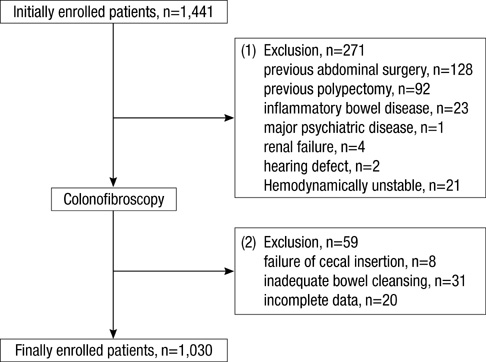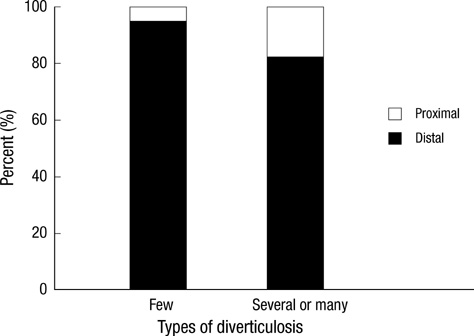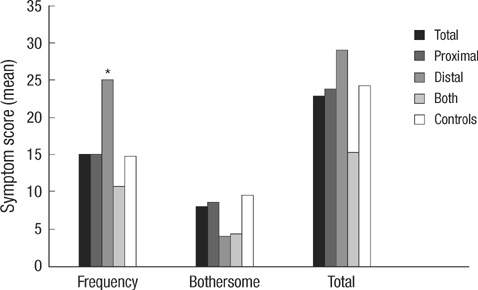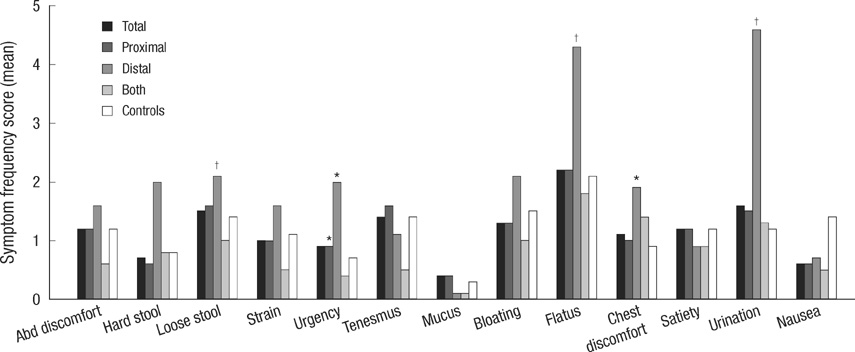J Korean Med Sci.
2010 Sep;25(9):1323-1329. 10.3346/jkms.2010.25.9.1323.
Clinical Significance of Colonic Diverticulosis Associated with Bowel Symptoms and Colon Polyp
- Affiliations
-
- 1Department of Internal Medicine, College of Medicine, The Catholic University of Korea, Seoul, Korea. cmcu@catholic.ac.kr
- KMID: 1785912
- DOI: http://doi.org/10.3346/jkms.2010.25.9.1323
Abstract
- This study was done to evaluate prospectively the clinical significance of colonic diverticulosis. In the 1,030 consecutive outpatients undergoing colonoscopy, the information on the demographics, the patterns of bowel symptoms, and the prevalence of colon polyp were analyzed according to the presence of colonic diverticulosis. The mean age of 1,030 patients were 52.2 yr and 59.3% were male. The prevalence of diverticulosis was 19.7% (203/1,030). Of 203 diverticulosis patients 85.2% were in proximal group, 5.4% in distal group and 9.4% in both group. Six (3.0%) patients were found to have diverticulitis. Multivariate logistic regression analysis showed that an old age, diabetes and the presence of polyp were significant factors associated with proximal or both diverticulosis. A significant difference was demonstrated between the patients of distal diverticular group and the controls for the symptom frequency scores within the previous 4 weeks. The items, which showed difference, were hard stool, urgency, flatus, chest discomfort and frequent urination. In conclusion, old age, diabetes and the presence of colon polyp were associated with proximal diverticulosis. The temporal symptoms were more frequent in distal diverticulosis than in proximal diverticulosis in the study subjects.
MeSH Terms
-
Adult
Age Factors
Aged
Aged, 80 and over
Colonic Diseases/diagnosis/epidemiology
Colonic Polyps/complications/*diagnosis
Colonoscopy
Diabetes Complications/complications/diagnosis
Diverticulitis/diagnosis/epidemiology
Diverticulosis, Colonic/complications/*diagnosis/epidemiology
Female
Flatulence/complications
Humans
Logistic Models
Male
Middle Aged
Prospective Studies
Risk Factors
Figure
Reference
-
1. Sheth AA, Longo W, Floch MH. Diverticular disease and diverticulitis. Am J Gastroenterol. 2008. 103:1550–1556.
Article2. Parra-Blanco A. Colonic diverticular disease: pathophysiology and clinical picture. Digestion. 2006. 73:Suppl 1. 47–57.
Article3. Jacobs DO. Clinical practice. Diverticulitis. N Engl J Med. 2007. 357:2057–2066.4. Takano M, Yamada K, Sato K. An analysis of the development of colonic diverticulosis in the Japanese. Dis Colon Rectum. 2005. 48:2111–2116.
Article5. Simpson J, Neal KR, Scholefield JH, Spiller RC. Patterns of pain in diverticular disease and the influence of acute diverticulitis. Eur J Gastroenterol Hepatol. 2003. 15:1005–1010.
Article6. Kieff BJ, Eckert GJ, Imperiale TF. Is diverticulosis associated with colorectal neoplasia? A cross-sectional colonoscopic study. Am J Gastroenterol. 2004. 99:2007–2011.
Article7. Aronchick CA, Lipshutz WH, Wright SH, Dufrayne F, Bergman G. A novel tableted purgative for colonoscopic preparation: efficacy and safety comparisons with Colyte and Fleet Phospho-Soda. Gastrointest Endosc. 2000. 52:346–352.
Article8. Radaelli F, Meucci G, Imperiali G, Spinzi G, Strocchi E, Terruzzi V, Minoli G. High-dose senna compared with conventional PEG-ES lavage as bowel preparation for elective colonoscopy: a prospective, randomized, investigator-blinded trial. Am J Gastroenterol. 2005. 100:2674–2680.
Article9. Park JM, Choi MG, Kim YS, Choi CH, Choi SC, Hong SJ, Jeong JJ, Lee DH, Lee JS, Lee KJ, Son HJ, Sung IK. Quality of life of patients with irritable bowel syndrome in Korea. Qual Life Res. 2009. 18:435–446.
Article10. Miura S, Kodaira S, Shatari T. Recent trends in diverticulosis of the right colon in Japan: retrospective review in a regional hospital. Dis Colon Rectum. 2000. 43:1383–1389.11. Chia JG, Wilde CC, Ngoi SS, Goh PM, Ong CL. Trends of diverticular disease of the large bowel in a newly developed country. Dis Colon Rectum. 1991. 34:498–501.
Article12. Nakada I, Ubukata H, Goto Y, Watanabe Y, Sato S, Tabuchi T, Soma T, Umeda K. Diverticular disease of the colon at a regional general hospital in Japan. Dis Colon Rectum. 1995. 38:755–759.
Article13. Kim BH, Lee SH, Lee SS, Oh DJ, Chung ES, Lee SJ. Diverticular disease of the colon in Korea. Korean J Intern Med. 1987. 2:79–83.
Article14. Petruzziello L, Iacopini F, Bulajic M, Shah S, Costamagna G. Review article: uncomplicated diverticular disease of the colon. Aliment Pharmacol Ther. 2006. 23:1379–1391.
Article15. Parks TG. Natural history of diverticular disease of the colon. A review of 521 cases. Br Med J. 1969. 4:639–642.
Article16. Imperiali G, Meucci G, Alvisi C. Segmental colitis associated with diverticula: a prospective study. Am J Gastroenterol. 2000. 95:1014–1016.
Article17. Painter NS, Burkitt DP. Diverticular disease of the colon: a deficiency disease of western civilization. Br Med J. 1971. 2:450–454.
Article18. Simpson J, Scholefield JH, Spiller RC. Origin of symptoms in diverticular disease. Br J Surg. 2003. 90:899–908.
Article19. Humes DJ, Simpson J, Neal KR, Scholefield JH, Spiller RC. Psychological and colonic factors in painful diverticulosis. Br J Surg. 2008. 95:195–198.
Article20. Comparato G, Fanigliulo L, Aragona G, Cavestro GM, Cavallaro LG, Leandro G, Pilotto A, Nervi G, Soliani P, Sianesi M, Franzé A, Di Mario F. Quality of life in uncomplicated symptomatic diverticular disease: is it another good reason for treatment? Dig Dis. 2007. 25:252–259.
Article21. Kang JY, Melville D, Maxwell JD. Epidemiology and management of diverticular disease of the colon. Drugs Aging. 2004. 21:211–228.
Article22. Otte JJ, Larsen L, Andersen JR. Irritable bowel syndrome and symptomatic diverticular disease: different diseases? Am J Gastroenterol. 1986. 81:529–531.23. Schoetz DJ Jr. Diverticular disease of the colon: a century-old problem. Dis Colon Rectum. 1999. 42:703–709.24. Bassotti G, Battaglia E, De Roberto G, Morelli A, Tonini M, Villanacci V. Alterations in colonic motility and relationship to pain in colonic diverticulosis. Clin Gastroenterol Hepatol. 2005. 3:248–253.
Article25. Akhtar AJ, Shaheen MA, Zha J. Organic colonic lesions in patients with irritable bowel syndrome (IBS). Med Sci Monit. 2006. 12:CR363–CR367.
Article26. Domjan J, Blaquiere R, Odurny A. Is minimal preparation computed tomography comparable with barium enema in elderly patients with colonic symptoms? Clin Radiol. 1998. 53:894–898.
Article27. Anderson JC, Messina CR, Cohn W, Gottfried E, Ingber S, Bernstein G, Coman E, Polito J. Factors predictive of difficult colonoscopy. Gastrointest Endosc. 2001. 54:558–562.
Article28. Mimura T, Emanuel A, Kamm MA. Pathophysiology of diverticular disease. Best Pract Res Clin Gastroenterol. 2002. 16:563–576.
Article
- Full Text Links
- Actions
-
Cited
- CITED
-
- Close
- Share
- Similar articles
-
- Recent trend of colonic diverticulosis
- Diverticulosis of colon: case report
- The Epidemiology and Etiology of Right-Sided Colonic Diverticulosis: A Review
- The Prevalence and Clinical Features of Colonic Diverticulosis Diagnosed with Colonscopy
- Colonic Diverticulosis: Evaluation wth Double Contrast Barium Enema





